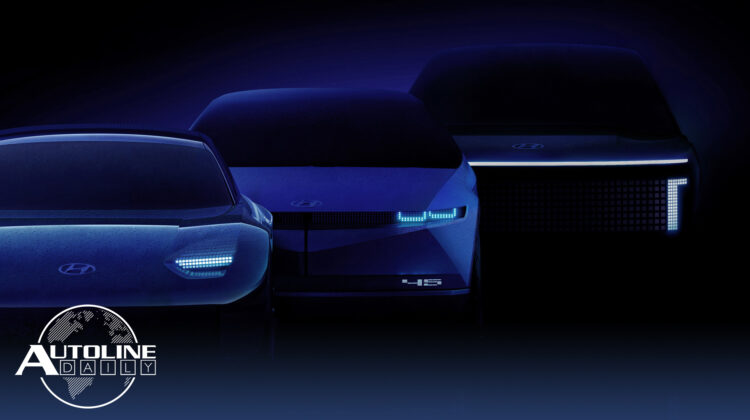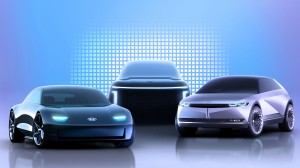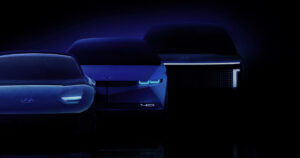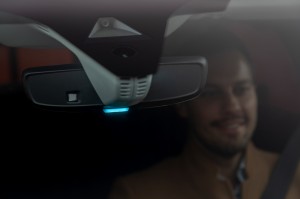
Listen to “AD #2892 – Hyundai Launches Ioniq EV Brand; Mahindra North America In Trouble; Fisker Signs Deal with Magna” on Spreaker.
Follow us on social media:
Runtime: 8:06
0:07 Hyundai Launches Ioniq EV Brand
1:05 Our Ioniq Insight
2:56 Mahindra North America In Trouble
4:08 Geely To Use Volvo Platforms Across Brands
5:01 Opel Uses Blue Light to Indicate Green Driving
5:54 Mobility Service Revenue Takes Huge Hit
6:40 Fisker Signs Tentative Manufacturing Deal with Magna
Visit our sponsors to thank them for their support of Autoline Daily: Bridgestone, Intrepid Control Systems and BorgWarner.
This is Autoline Daily, the show dedicated to enthusiasts of the global automotive industry.
HYUNDAI LAUNCHES IONIQ EV BRAND
Hyundai announced it is launching an all-EV brand and they’re going to call it Ioniq. The brand will get three new models over the next four years. The first one out of the box will be the IONIQ 5, a midsize CUV that comes out early next year. It’s based on the concept EV called the 45. Then, in 2022, they’ll come out with the IONIQ 6 sedan, which is based on Hyundai’s most recent concept car, the Prophecy. And in 2024, they’ll come out with the IONIQ 7. Notice the naming strategy. All these models have numbers as names, with even numbers being sedans and odd numbers being CUVs and SUVs. They’re all going to be built on a new dedicated EV platform. Hyundai has a goal of selling one million EVs by 2025 and becoming the third largest producer of “eco-friendly vehicles.”
OUR IONIQ INSIGHT
Here’s our Autoline Insight. A million EVs with only three models is awfully ambitious. But Hyundai says it will add more models to the lineup. One thing’s for sure, the stock market sure liked the news. Hyundai’s stock jumped 10%. And all this must make General Motors want to pull its hair out. When it unveiled the Lyriq EV last week and boasted how Cadillac will become an all-electric brand, the stock market largely ignored the news. GM stock went up 10 cents. And then there’s the name that Hyundai chose, Ioniq. Cadillac just made a big deal about how all its EV models will end in “iq,” and now Hyundai comes out with an entire brand that ends in “iq.” To drive the point home, Hyundai even used lights to make the famous London Eye look like a giant Q. General Motors is doing some impressive development with EVs, but it seems to fall flat when it comes to getting the message out.
MAHINDRA NORTH AMERICA IN TROUBLE
Looks like Mahindra’s operations in North America are all but dead. The company is pulling out of a competition to earn a contract to build vehicles for the U.S. Postal Service due to the high investment cost, which is estimated to be about $500 million for Mahindra. And as we previously reported, Mahindra lost a lawsuit with FCA that essentially says its Roxor off-road vehicle looks too much like a Wrangler, which means it can no longer sell, build or import parts for the Roxor in the U.S. Mahindra is appealing the decision, but says that its North American business is also under review and makes it sound like its fate all hinges on that appeal. But it’s not all bad news at Mahindra. The company says it’s looking for financial and strategic investors for its push into electrification. It wants to make mass-market EVs in India through its domestic unit Mahindra Electric and high-end EVs for Europe through Pininfarina. Mahindra is even considering a partner for its deal with Pininfarina.
GEELY TO USE VOLVO PLATFORMS ACROSS BRANDS
Geely is leveraging its partnership with Volvo to slash development time and lower costs. The automaker will use the modular architectures it’s been developing with Volvo since 2013 to build new models in Malaysia under its partly owned domestic brand, Proton, as well as for its Geely and Lynk&Co brands in China. The two platforms will allow Geely to develop, design and build vehicles faster and at a lower price than before. For example, it takes Geely about 18 months to significantly change a car that uses a modular architecture, versus 24 to 30 months for a vehicle that doesn’t. Geely has ambitions to become China’s largest global automaker and currently sells about 2 million vehicles worldwide across all of its brands.
OPEL USES BLUE LIGHT TO INDICATE GREEN DRIVING
A number of cities in Europe only allow electric vehicles to operate in certain areas to help curb pollution. So to make it easier for law enforcement to know when a vehicle is in electric only mode, Opel has come up with an interesting solution. When its Grandland X plug-in hybrid is operating in electric-only mode, a blue light, located in the windshield just below the mirror, turns on to indicate that it’s running only on electricity. It’s a pretty simple but clever solution.
MOBILITY SERVICE REVENUE TAKES HUGE HIT
People aren’t travelling as much or in the ways they used to because of the coronavirus. And according to Buy Shares, it’s going to put a huge dent in the global mobility services market. It says that revenue will plunge by $450 billion this year. The mobility services market includes flights, taxis, long distance bus travel and trains, car rentals and car sharing. The past two years, the market topped a trillion dollars in revenue but this year it’s only expected to generate $616 billion. The market isn’t expected to return to pre-COVID levels until at least 2023.
FISKER SIGNS TENTATIVE MANUFACTURING DEAL WITH MAGNA
EV startup Fisker signed a tentative deal with Magna to have the supplier build its Ocean SUV. If the deal goes through, the vehicle will be built at Magna’s plant in Austria starting at the end of 2022. Fisker said it’s also looking at manufacturing options in the U.S. and China. It makes sense that Fisker would choose Magna, which already builds the electric I-Pace for Jaguar. It also makes the Toyota Supra, the BMW Z4 and Mercedes G-Wagon. Fisker wants to make his EV by using Volkswagen’s MEB platform.
Coming up later this week on Autoline After Hours, we’re going to look at how aftermarket companies that modify vehicles will have to recalibrate the ADAS sensors. If you raise or lower a vehicle, the radar and sonar sensors and video cameras have to be adjusted or the vehicle will not be safe. It won’t be legal to sell, either. Fortunately, there are solutions for all this and that’s what we’ll be getting into.
But that wraps up today’s show, thank you for watching.
Thanks to our partner for embedding Autoline Daily on its website: WardsAuto.com

John McElroy is an influential thought leader in the automotive industry. He is a journalist, lecturer, commentator and entrepreneur. He created “Autoline Daily,” the first industry webcast of industry news and analysis.









